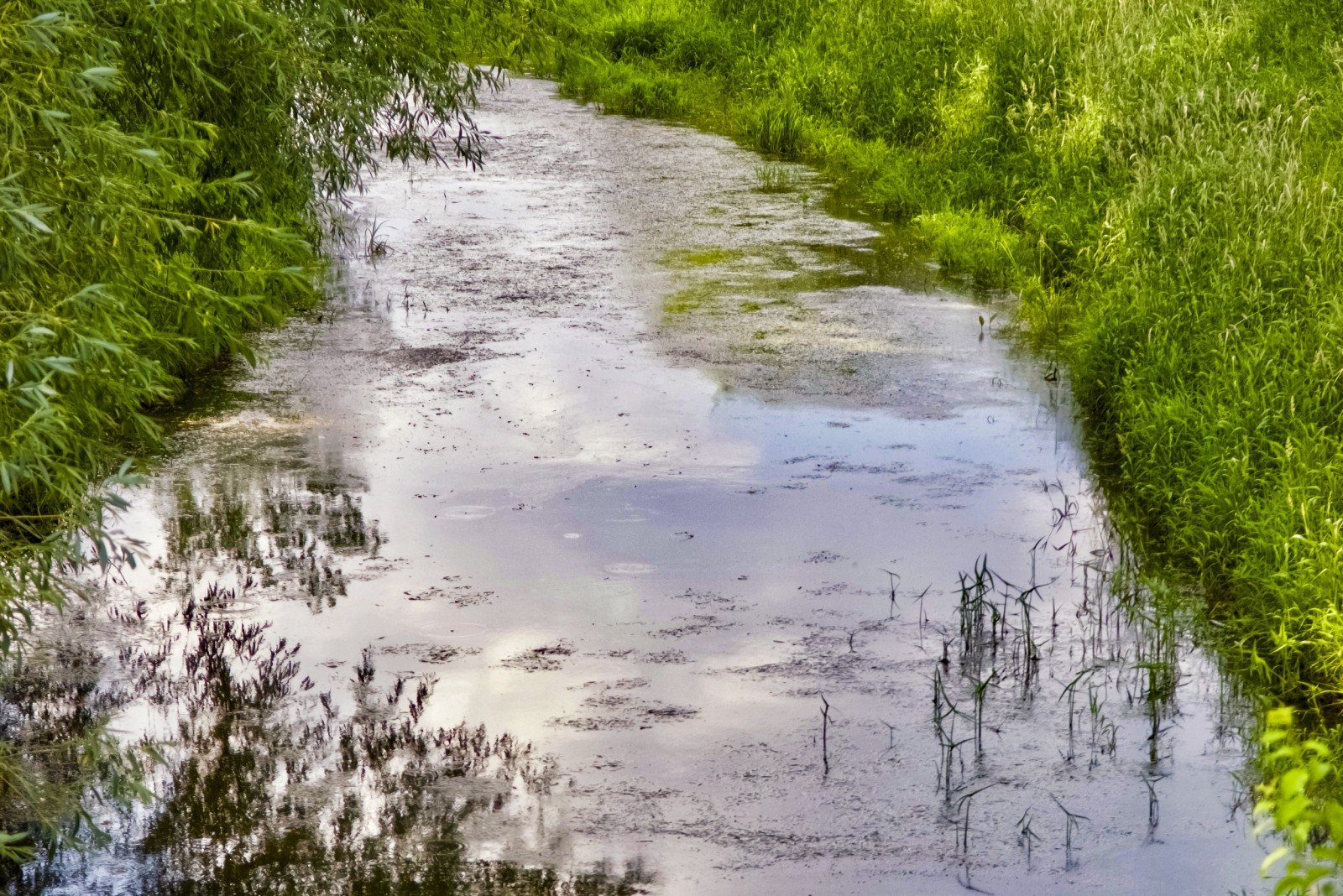The Stream, April 3, 2024: Salty Drinking Water in Bangladesh, a Growing Problem, Sickens Pregnant Women

The headwaters of the Cedar River, which flows 338 miles from southern Minnesota through Iowa, are choked by algae, the result of excess farm nutrients running off farm fields and from large swine production facilities. Photo by Keith Schneider / Circle of Blue
YOUR GLOBAL RUNDOWN
- In Zimbabwe, which has Africa’s largest lithium reserves, mining has taken precedence over environmental protections, water quality, and human safety.
- As drought in the Amazon persists, thousands of wildfires are raging across Venezuela.
- Close to 800,000 freshwater fish were killed in Iowa and Missouri after a massive spill of liquid nitrogen fertilizer into waterways.
- Headaches, organ failure, and even death are befalling a number of pregnant women in coastal Bangladesh, where drinking water is becoming contaminated with salt.
Warnings of a global “chocolate meltdown” have been shared as cacao harvests in Ghana and Ivory Coast have been limited by extreme heat and drought.
“There is a large shortage of fresh cacao beans. Normally there is a global crop of about 5 million tonnes. Now it’s about 0.5 million tonnes less… you cannot just plant more cacao trees and expect production to increase [in] the following years, because they are trees.” — Martijn Bron, a former head of cocoa trading for the commodity giant Cargill.
Cacao prices reached an all-time market high last week, trading at more than $10,000 per tonne — higher than copper prices — as West African harvests have stumbled amid high temperatures and low rainfall spurred by both climate change and El Niño weather patterns, The Guardian reports. The global shortage of the bean, from which chocolate is made, has hit the bottom lines of the world’s largest chocolate producers, including Nestlé. The size and quantity of chocolate products may be reduced if the shortage continues. Disease and plantation underinvestment, per The Guardian, have also contributed to the crop’s decline.
Meanwhile, cacao farmers themselves aren’t reaping the benefits of a demanding market, as Ghana and Ivory Coast’s governments have sold much of the raw crop to the cartel that facilitates the bean’s export and supply chain.
— Christian Thorsberg, Interim Stream Editor
Recent WaterNews from Circle of Blue
- World Water Day Reflects on Conflicts, Peace — Unreliable water is a significant social risk.
- Can U.S and Mexico Secure Water Supplies in Shrinking Rio Grande? — Changes are needed in 80-year-old water treaty to accommodate the drying climate.
The Lead
More than 20 women are forced to share single hospital rooms in southwestern Bangladesh, where new and expectant mothers are suffering from pre-eclampsia, eclampsia, and hypertension — conditions whose causes are being linked more and more to the rise of salinity in the region’s drinking water, The Guardian reports.
In recent years Dacope, a rural region, has seen its inland rivers, ponds, and groundwater reserves become inundated with salty seawater. Both sea level rise and saltwater intrusion — spread through storms and cyclones — officials say, are the main cause. The salty water is also impacting the menstrual health and hygiene of young women and girls.
Collecting and storing rainwater in barrels is not an option for everyone, as many homes lack the required infrastructure. And filtering water is expensive, outside the means of many families who instead get their water from ponds shared by thousands of people.
Local doctors are currently monitoring the health of some 5,000 pregnant women and spreading awareness about water quality in the community. “Climate change and rising sea levels will further exacerbate salinity issues here in the future,” Santosh Kumar, a gynecologist at the hospital in Dacope, tells The Guardian. “All the women and girls in the area are at threat. Without easy access to safe drinking water, their reproductive health will deteriorate.”
This Week’s Top Water Stories, Told In Numbers
30,200
The number of distinct fire points satellites have detected so far this year in Venezuela, as the country’s forests and grasslands succumb to a combination of high heat and low rainfall, Reuters reports. The drought which has spread across northern South America this year has been exacerbated by El Niño weather patterns, sparking large, raging wildfires months before the region’s usual fire season. More than 400 firefighters this weekend battled blazes nearby Henri Pittier National Park, and across Venezuela’s Amazon close to 6,000 fires were still active as of late March. Regional rainfall levels have only reached between 10 percent and 25 percent of their usual average in the past 30 to 90 days.
789,000
Number of fish killed in over 60 miles of waters which flow into the Missouri River, after 265,000 gallons of liquid nitrogen fertilizer were accidentally spilled in a drainage ditch, the New York Times reports. The vast majority of the fish — which include minnows, shiners, catfish, carp, and shovelnose sturgeon — were killed in Iowa, though some 40,000 fish in Missouri were estimated to have died. It was one of the five largest “fish kills” recorded in state history.
In Context: Toxic Terrain — Fertilizer and manure in the U.S. Corn Belt contaminate water and ruin the quality of life.
On the Radar
In Zimbabwe’s Bikita and Gutu districts, government officials are working to realize a $12 billion lithium economy — and won’t pause for environmental consideration to achieve it, frustrated local communities tell Mongabay.
To clear land for the construction and development of mines — including the Bikita mine, the largest in the country and whose exports last year totalled $500 million — farmers have had their land razed and replaced with roads and power lines. In some instances, community members have been forced to leave their ancestral lands for other parcels. Many have reported not yet receiving the compensation they were promised.
Meanwhile the Mungezi River, whose waters have supported lives and livelihoods for generations, has also had its health decline as operations pick up. Riparian communities say toxic chemicals, discharged from the mine owner Sinomine, have become more concentrated in the river’s flows. Zimbabwe’s Environmental Management Agency confirmed the spillage and fined the mine, though it refused to disclose which chemicals were released. And at the mine itself, harsh labor conditions — including workers’ rights violations and a death late last year — have been reported, with little transparency or company accountability being shared.
More Water News
Millet: In Colorado and across the U.S., millet — a drought-resistant crop that grows well in heat — is gaining popularity among farmers adjusting to drier, warmer climates, Yale Climate Connections reports.
Kenya’s Sand Dams: Villagers are working diligently to construct homemade dams made from sand and concrete, which would allow for the harvesting of water from seasonal rivers amidst otherwise arid conditions, AP reports.
Christian Thorsberg is an environmental writer from Chicago. He is passionate about climate and cultural phenomena that often appear slow or invisible, and he examines these themes in his journalism, poetry, and fiction.






Leave a Reply
Want to join the discussion?Feel free to contribute!